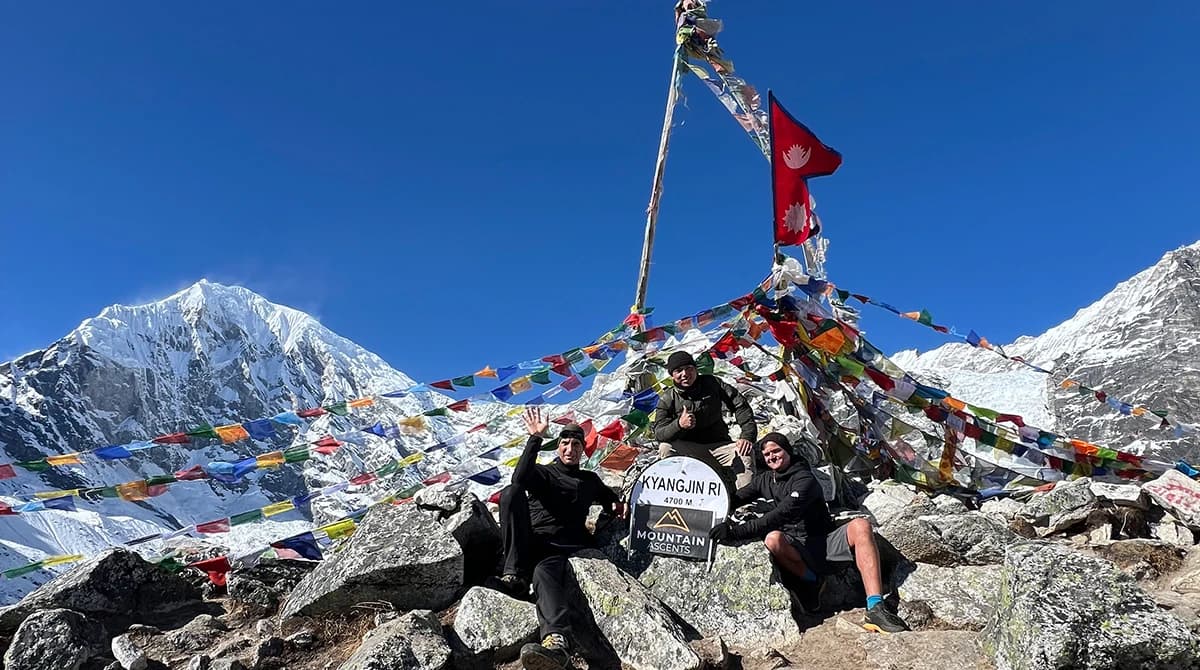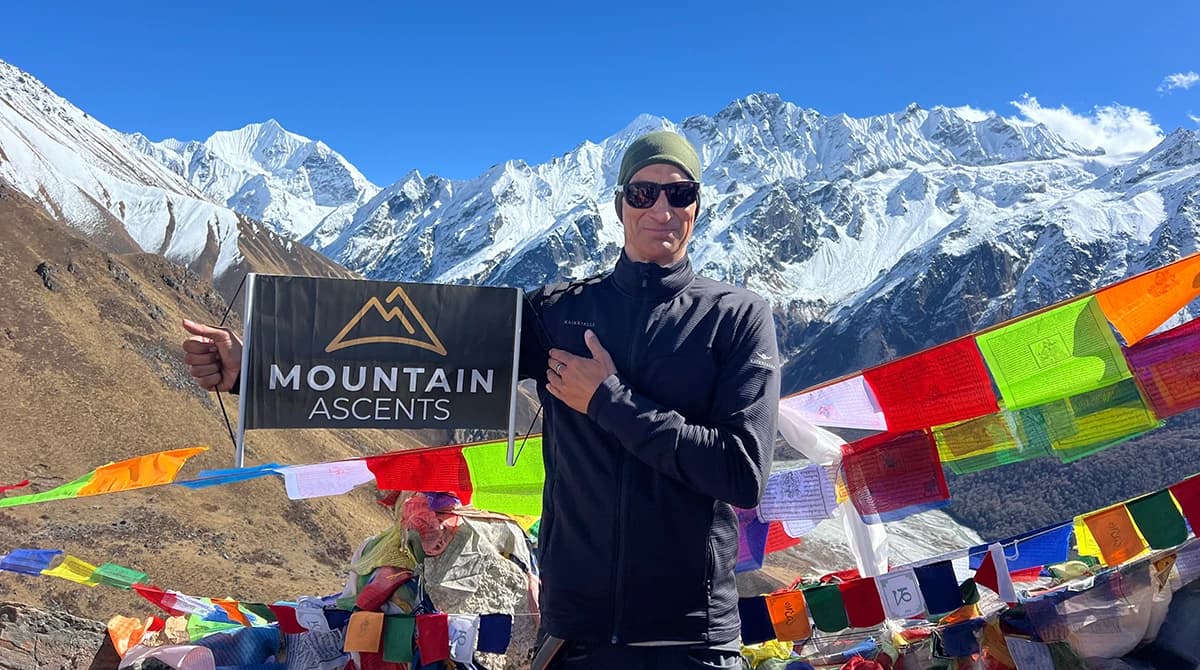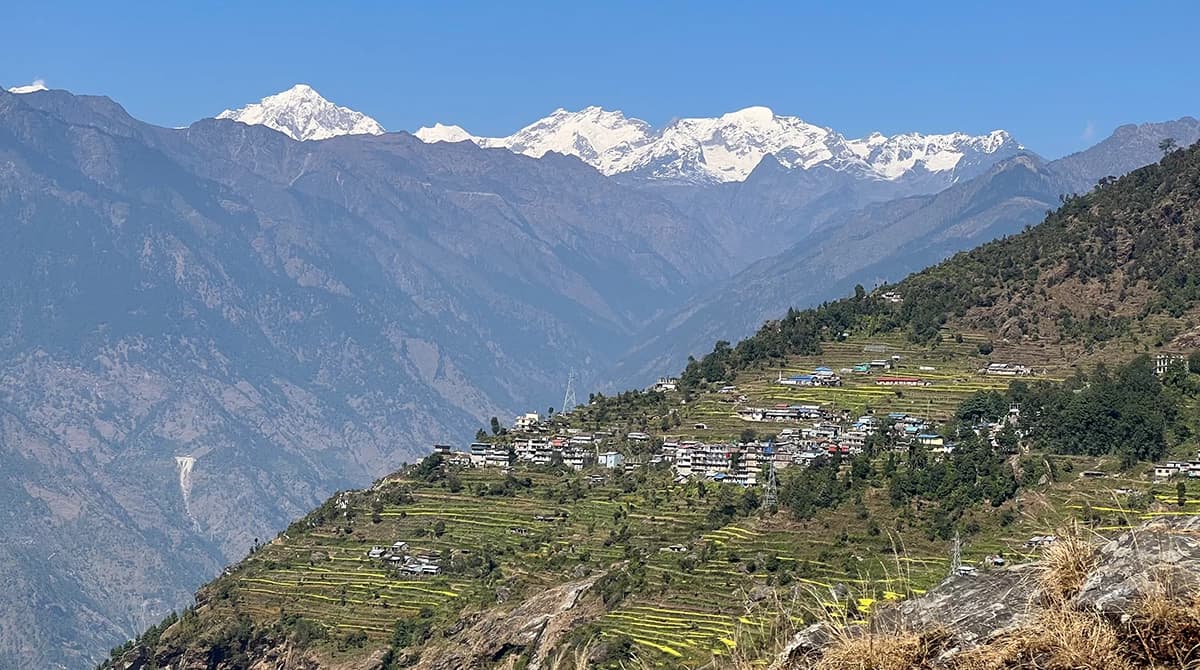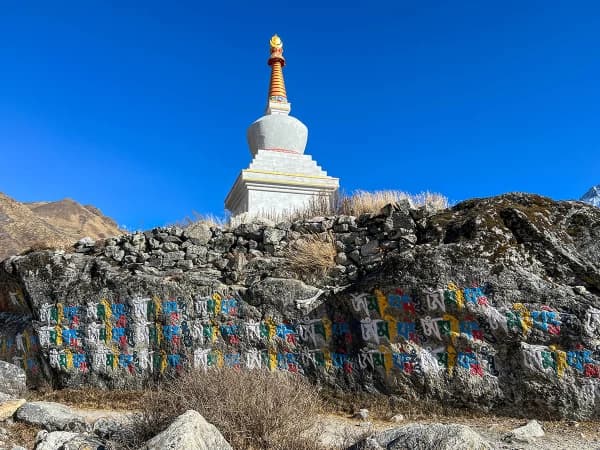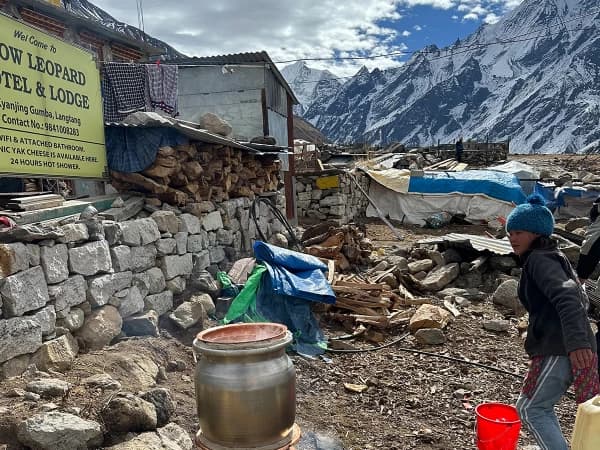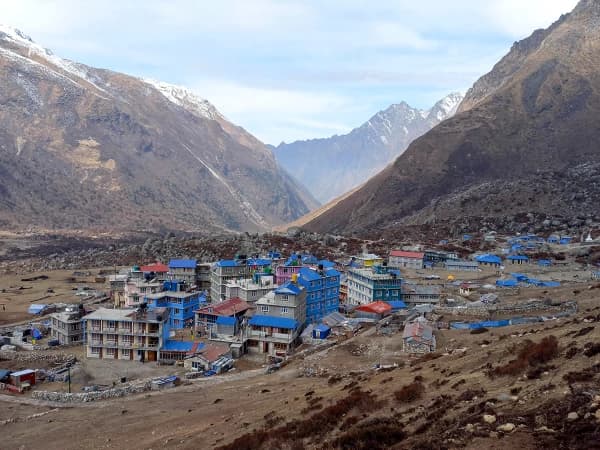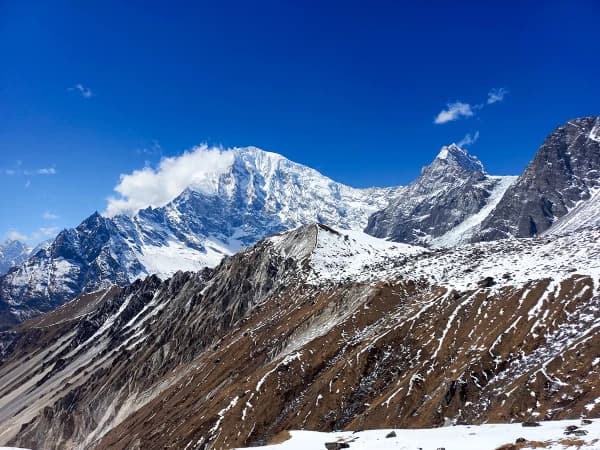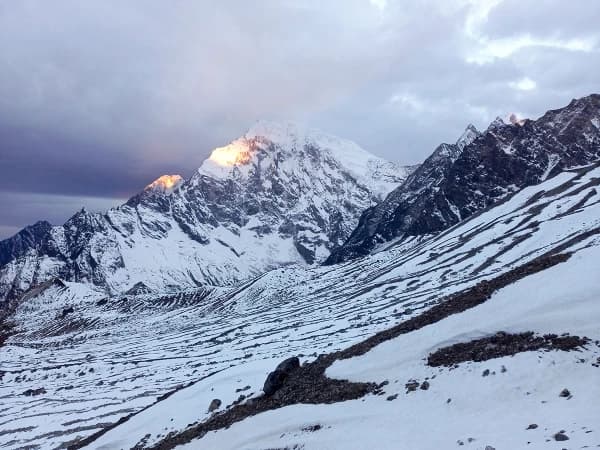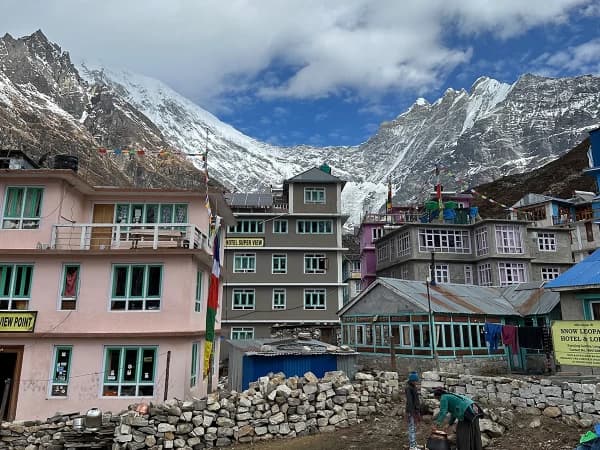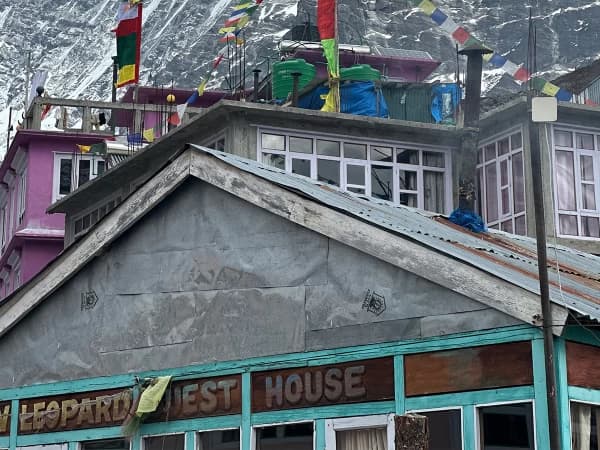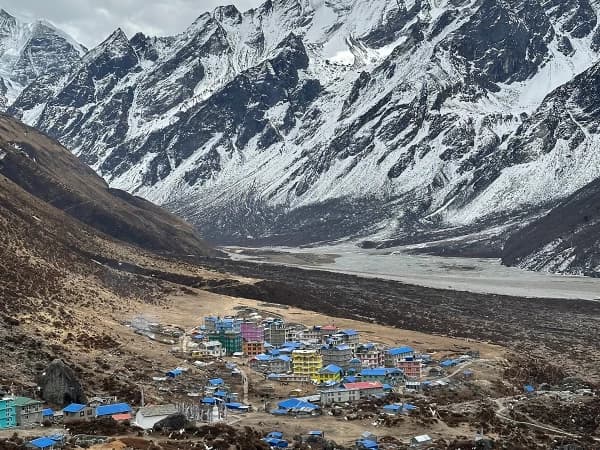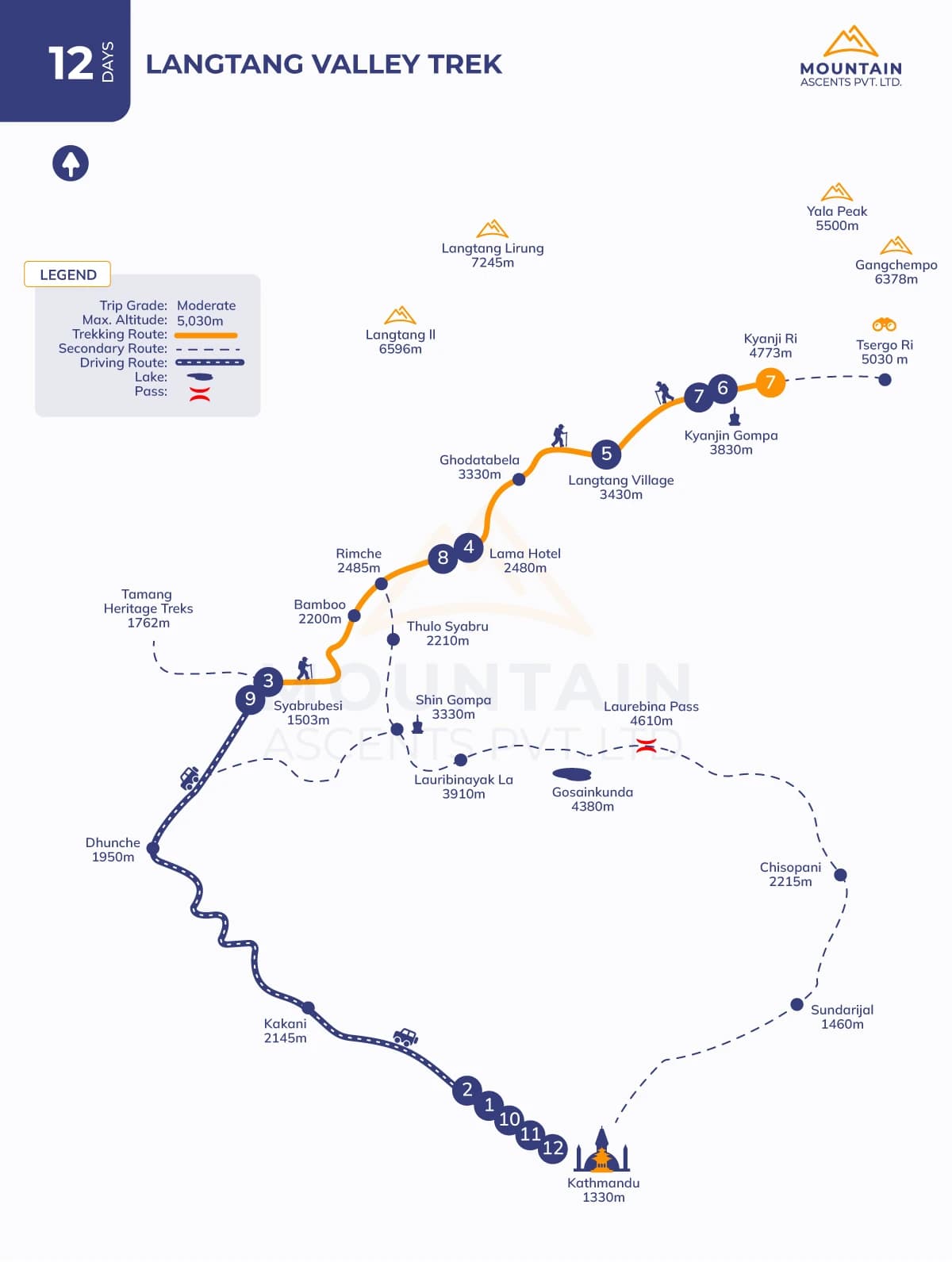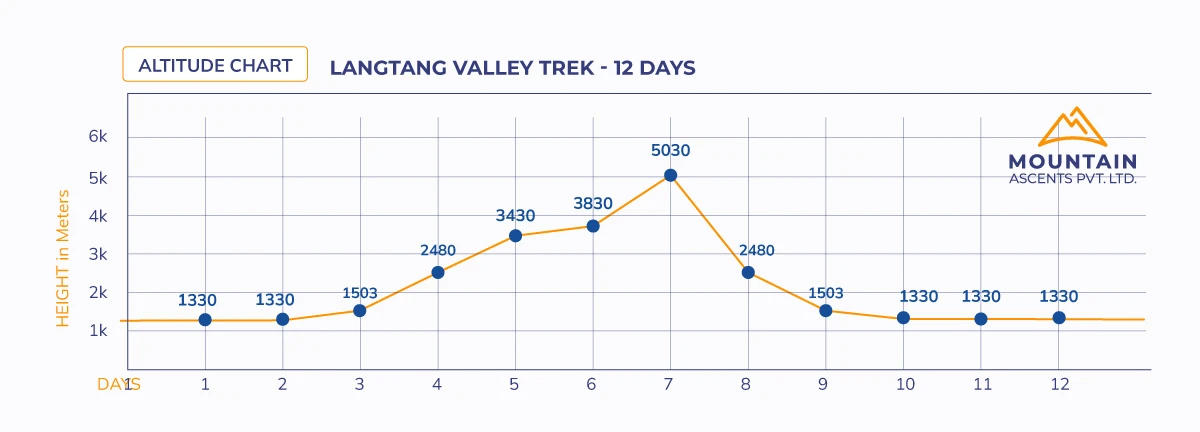The Langtang Valley Trek is a classic Himalayan journey to the land often referred to as the “Valley of Glaciers,” offering a pristine and picturesque escape from hazardous city life in a short time. Located north of Kathmandu, the capital city of Nepal, the Langtang Valley Trekking Trail is across the beautiful Langtang Trekking Region. Renowned for its unspoiled beauty, the native hidden culture of the Tamang, and exceptionally stunning mountain vistas, this Himalayan route is a once-in-a-lifetime chance to see the Tamang and Sherpa peoples' traditional ways of living while also taking in the breathtaking scenery of the Himalayas.
The trek to Langtang itinerary starts in Syabrubesi; from there, it's an uphill climb to Lama Hotel and Langtang village via Ghoda Tabela. Following the forest trails for the first few days brings you to the village, where you can view the towering peaks of Langtang Lirung, Kimshung, and Langshisha Ri. Starting in Langtang Village, make your way to Kyanjin Gompa. Then, in the early morning hours, climb to the viewpoint of Kyanjin Ri. At 4,773 meters (15,659 ft) above sea level, Kyanjin Ri stands as the trip's highest point. The Langtang and Ganesh Himal mountains, two of the most prominent in the Himalayas, provide stunning backdrops for the hike.
Nestled within the Langtang National Park, the first Himalayan National Park of Nepal, just 125 km away from Kathmandu, trekkers during the Langtang Valley Trek encounter diverse wildlife as they ascend through the Langtang River, passing by lush forests of rhododendrons and bamboo, cascading waterfalls, and picturesque villages. Each step unfolds a new perspective of the awe-inspiring Himalayan vistas of snow-capped peaks, including Ganesh Himal, Langtang, Lirung, Dorje Lakpa, and others.
Come along with us on this amazing journey off the beaten Langtang Valley Trekking Trail and discover the unique fusion of cultures of Tamang, Sherpa, and Tibetans with charming natural wonders further enhanced by the warm hospitality of locals as you soak in the rich spiritual energy of the Langtang Himalayas without any hassle at the most reasonable package cost!
Trip Highlights
- Explore Nepal’s city of temples with at least seven of the UNESCO World Heritage Sites before and after the trek.
- Enjoy an amazing drive to Syabrubesi along the rigorous rivers, traditional Nepalese settlements, terraced farms, lush hills, and mountain views.
- Embark on one of the less frequented pristine Himalayan trekking trails to the Langtang Valley, Nepal's infamous “Valley of Glaciers”.
- Walk through the Himalayan National Park and its dense forests, offering ample opportunities for sightseeing wildlife, including rare species of pandas, Himalayan Tahr, musk deer, and so on.
- The firsthand cultural experience of the Tamangs and Tibetan Buddhist traditions.
- Panoramic views of Langtang Ri, Langtang Lirung, Lang Shisha, Ganjala Peak, and others.
- Visit the ancient Buddhist shrine dipped in immense spiritual energy, Kyanjin Gompa.
- Climb Kyanjin Ri (4,773 m/15,655 ft), one of the highest peaks in the Langtang Valley, for 360-degree expansive views of the surrounding Himalayas and Valleys, etc.
What makes the Langtang Valley Trek special?
The Langtang Valley Trekking is a special journey to the Himalayas that offers a harmonious blend of adventure, culture, and natural splendor in proximity to the capital city of Nepal. Starting and ending at Syabrubesi or Dhunche, it is one of the country’s most rewarding and accessible trekking routes, ideal for novice, budget-friendly, and limited visa date individuals hopeful of immersing themselves in the serene Himalayan beauty.
Though the trekking trail is one of the short and easily accessible ones, it stands out as a less frequented Himalayan route of Nepal, rewarding immensely with spectacular mountain vistas and a sense of accomplishment on completion. Trekkers embark through diverse landscapes and alpine lands rich in distinctive cultures and traditions, allowing them to appreciate encounters with a wide range of flora and fauna. It is one of the best Himalayan odysseys for someone seeking an authentic Himalayan experience promising a deeper insight into the rural mountain life, glaciers, nature's grandeurs, and ancient religious monasteries to expect:
Proximity to Kathmandu
Unlike some of the popular Himalayan trekking trails in Nepal, such as the Annapurna Base Camp, Everest Base Camp, Annapurna Circuit, Manaslu Circuit, Upper Mustang Valley, and others, the Langtang Valley Trekking Route is one of the closest trekking destinations to the country’s capital, Kathmandu. The trek starting point, Syabrubesi, is only 122 km, 7-9 hours drive from Kathmandu through interestingly winding roads followed by alluring views of terraced farms and villages along the bank of rivers below the lush hills.
For trekkers with limited time, the trek offers a quick escape into the heart of the Himalayas, boasting an unmatchable natural splendor. Trip cancellations and delays are very rare, unlike during the Everest Trek, which typically begins with a mountain flight to Lukla. This results in almost 100 percent guaranteed treks even during the times considered off-trekking season in Nepal: summer/monsoon and winter.
Scenic diversity of the Langtang National Park
The Langtang Valley Trek passes through one of Nepal's 12 national parks, the Langtang National Park. A permit is required to enter the area, which is usually checked in Dhunche. Established in 1976, it is Nepal’s first Himalayan National Park, spread over 1,710 square kilometers. It is home to several ethnic communities, especially those who have closer cultural ties to Tibetan Buddhism: Tamangs and Sherpas.
The National Park area features varied landscapes from Syabrubesi to Kyanjin Ri, including subtropical forests, alpine meadows, glaciers, and close-up panoramic views of sky-towering peaks like Langtang Lirung, Langshisha Ri, Dorje Lakpa, and neighboring peaks. On the way, trekkers can also encounter a wide array of flora and fauna, including rare snow leopards, red pandas, and Himalayan tahr, along the densely packed forests of rhododendrons and bamboo.
If you like, you can extend your trek with a side trip to another religious and cultural sacred site beside the Kyanjin Gompa, the alpine Gosaikunda Lake, at an altitude of 4,380 m above sea level, showcasing the unique culture, traditions, and way of life of Tamang and Tibetan communities. As you move along the shimmering rivers, waterfalls, and glacial valleys during the Langtang Valley Trekking, you will be astonished by the striking biodiversity and sky-perching mountain ranges of the Langtang National Park, making it a haven for both the trekkers and nature enthusiasts.
Rich Nepalese Culture and Heritage
The Langtang Valley Trekking is through the Langtang region of Nepal, inhabited largely by Tamang and Sherpa communities, native to the Himalaya region of the country, similar to that in the Everest region, differing in clan. Though both indigenous ethnic groups of Nepal follow Tibetan Buddhism and reflect strong Tibetan influence, they have distinctive cultures, customs, traditions, attire, and dialects.
Translation to “horse warriors” in Tibetan, Tamang’s language belongs to the Tibeto-Burman language family with traditional musical instruments like the damphu and vibrant cultural dances like Selo. Most still reside in stone-roofed houses with wooden-carved windows and treasures: gompas, monasteries, Mani walls, and prayer flags. They celebrate “Losar” and are known for their resilience, warm hospitality, friendly nature, and deep spiritual connection to the mountains and nature.
During the Langtang Valley Trek, trekkers walk past, visit, and see several culturally, religiously, and spiritually significant monuments in addition to typical houses in the traditional villages, adding notable depth to the trekking experience.
Snow-capped panorama from Kyanjin Gompa and Kyanjin Ri
Trekkers on the way to Langtang Valley are blessed with a stunning panorama from the Kathmandu Valley. As you ascend more and more to the prime destination, i.e., the Kyanjin Gompa and the peak called Kyanjin Ri, the panoramas become more and more striking. Langtang Lirung (7,227 m), Dorje Lakpa, Ganesh Himal, and neighboring peaks appear to play hide and seek along the dense forests of bamboo and rhododendrons along the route. At the same time, several high-altitude landmarks provide you with unparalleled 360-degree views.
Located at 3,870m above sea level in the Langtang Trekking Region, Kyanjin Gompa is a Buddhist monastery amidst the stunning Himalayan panoramas. Dating back centuries, the Gompa above the village, named after the Gompa itself, serves as one of the best vantage points to appreciate the Langtang Himalayas, besides being a spiritual and cultural hub for locals and trekkers alike. Known for its ancient Tibetan Buddhist traditions, gorgeous mountain views, and peaceful ambiance, the Gompa provides you with an excellent spot to meditate and self-reflect to connect with oneself, the mountains, and the tranquil nature to the fullest.
Nearby the Gompa is a peak called Kyanjin Ri. Nestled in the heart of the Langtang Himalayas, 4,773 m/15,655 ft above sea level, the peak is a short yet steep and equally rewarding climb from Gompa. Besides its 360-degree expansive panoramic views of the surrounding Himalayas peaks, the summit has extraordinary views of the Langtang region’s glaciers and lush valleys, including the Langshisha Kharka meadow, making the Langtang Valley Trek worth a trek.
Resilience and Recovery of the Langtang Trekking region in serenity
The Langtang Trekking Region of Nepal has showcased remarkable resilience and recovery since the 2015 earthquake. The region was heavily impacted by the massive catastrophe, which devastated villages and trails significantly. That now has been restored, rebuilt, and enhanced into a safer route with preserved cultural heritages, improved infrastructure, and natural charms by resilient locals along the way to Langtang Valley.
The entire region, offering the tranquil beauty of varying Himalayan landscapes, cultural heritage, and warm local hospitality promising a serene and inspiring journey, stands as a testament to strength, renewal, and hope. Therefore choosing Langtang Valley Trekking is one of the ways to support the local communities and contribute to the recovery, book the Langtang Valley trip with us now for a life-changing experience that can aid in reestablishing one of the magnificent Himalayan routes of Nepal.
The 12 Days Best Langtang Valley Trek itinerary and cost for 2025 and 2026
The Langtang Valley Trek 12 Days is a moderate, low-altitude-level trek suitable for both novice and experienced trekkers that can typically span anywhere from 7-12 days or more based on the walking pace of trekkers, acclimatization days, and side trips. Usually, the trek commences with an adventurous drive to Dhunche or Syabrubesi and takes you through the Langtang National Park, making way through the traditional villages of Lama Hotel, Langtang Village, Kyanjin Gompa, and eventually to Kyanjin Ri.
On reaching Kyanjin Ri, begin the returning journey through the same route you used to ascend, concluding at the Kathmandu Valley to revisit, unwind, and explore several historical and cultural monuments. This Himalayan trip progresses through lush forests and Tamang villages, offering a perfect combination of breathtaking landscapes featuring majestic mountains, glaciers, and alpine meadows in high altitudes. Usually, the trek is below 5,000 m, even the highest point being at Kyanjin Ri itself at 4,773 m/15,655 ft above sea level, and hence has a very low chance of Acute Mountain Sickness (AMS), commonly called altitude sickness.
Further, in several leading government-licensed trekking companies in Nepal, including Mountain Ascents, trekkers can get a customized itinerary as per their needs, preferences, and time constraints; however, the Langtang Valley Trekking 12 Days itinerary stands out like none other for a comprehensive experience. This route allows you to take in all that the Langtang Trekking region of Nepal has to offer without feeling rushed, also leading to proper acclimatization as you maintain your pace. Usually, this standard Langtang Valley Trekking Cost can range anywhere from USD 850 to USD 1,200 per person, including essential permits, transportation used, food, accommodation, and guides (including their salary, meals, travel insurance, and trekking equipment).
For 2025 and 2026, we are offering special early bird group discounted prices on any trip you do with us, including for the Langtang Valley Trek Cost. Contact us now and book your seat; we are very eager to take you to your dream destination, be it to the Everest Himalayas, Annapurnas, or Langtang.
